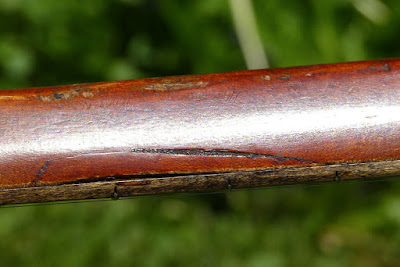1927 Oscar Schmidt "Stella" 12-String 000-Size Guitar
The folks who sold this guitar to my customer IDed this as a 1927 Stella and I have no problem with that dating. These are so rare. Yes, it's the "Leadbelly" or "Blind Willie McTell" guitar. Before work -- it was awesome. After work -- still awesome, but plays more "modern." I used to have a big lust for that old Leadbelly sound... and I'll tell you... this is that tone. It's big, warm, rich, percussive, and vibrant. That Oscar Schmidt bracing sure helps, though, as their builds tend to the warm and mellow side of ladder bracing (a good thing).
My own work included cutting a new compensated bone saddle, replacing the pins all around, string ramps, a light fretboard plane and refret (as well as board touch-up), cleaning, and full setup. It sings and begs me for a rendition of "Your Southern Can is Mine."
The body is a long 20" with a 14 7/8" lower bout. This effectively makes it similar to a 12-fret 000 with a bit more depth and slightly narrower. The long scale length (26 1/2") means the neck handles more like it's 14 frets out but puts the bridge in the perfect location.
The folks who had this before my hands touched it installed some carbon rods to reinforce the neck (good!) which means that rather than warping more and more as you get up to pitch, the relief only pops up 1/64" or so overall. Still, I've got it strung with regular 12-string "XLs" or 47w-10 and tuned down C-C or B-B. These are simply not built to go higher due to their long (26 1/2") scale length.
My new frets are a thinner medium stock and I love the feel of these. They're roughly the same size as the old OS brass ones... but they're not rectangular in shape... heh heh. I had to plane and refret because a good portion of the brass originals were wiggly in their slots which meant I couldn't perform an accurate level/dress.
Purty, purty, huh?
The guitar is solid spruce over solid birch.
The back has a few longer hairline cracks... but amazingly... they simply don't go through the wood. I've filled and sealed them... for looks.
This has a tucked-in bit of replacement wood where a bolt once lived. This is someone else's work and the job was well-done. The bolt-hole is still visible at the neckblock on the inside, as proof of a vintage repair gone a little awry...!
The "gear over" tuners actually work pretty well and must've been lubed-up before as they turn smoothly.
Aside from the (new) replacement rosewood pins I added at the bridge, I also added a vintage OS endpin from my parts bin to replace a cheesy plastic one.
Here you can see the compensated slots on the saddle. They're not different heights, but the "tooth" effect is created by different slot lengths. This angle lets you see the "break" of them and so you can see how I've compensated some farther forward and some farther back for each octave string. The saddle itself is on a uniform "level" along the top, which you can see in the other photos, but has sloping "front edges" on the compensated parts to kick the compensation back.
Someone had a nice custom Cedar Creek case made for the guit. Extra gravy!























Comments